20 – 25 SEPTEMBER 2025
By Andrew Walker
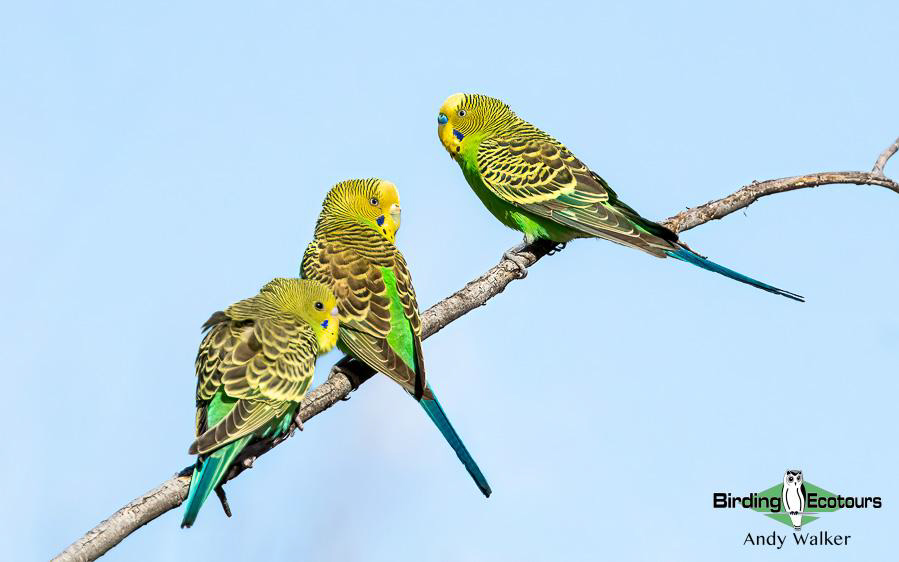
Budgerigars were present in good numbers during the tour and allowed for fantastic views.
Overview
This Alice Spring birding tour started in the town of Alice Springs on the 20th of September 2025 and ended back there on the 25th of September 2025. This short bird tour focused on birding around Alice Springs but ventured further afield to Uluru-Kata Tjuta National Park; this area is included on the UNESCO World Heritage List for its natural and cultural values. We visited both spectacular rock formations, as well as calling in to Erldunda, the geographical center of Australia!
We recorded 94 bird species on this Alice Springs birding tour, and all species were seen. You can also see our eBird trip report, here. Plenty of specials of the “Red Center” were found, including Spinifex Pigeon, Diamond Dove, Australian Bustard, Wedge-tailed Eagle, Spotted Harrier, Black Falcon, Red-backed Kingfisher, Rainbow Bee-eater, Pink Cockatoo, Budgerigar, Australian Ringneck, Mulga Parrot, Ground Cuckooshrike, Spinifexbird, Dusky Grasswren, Rufous-crowned Emu-wren, Purple-backed Fairywren, Splendid Fairywren, White-winged Fairywren, Slaty-backed Thornbill, Redthroat, Red-browed Pardalote, Banded Whiteface, Southern Whiteface, Western Bowerbird, Grey-headed Honeyeater, Crimson Chat, White-backed Swallow, Chiming Wedgebill, Copperback Quail-thrush, Hooded Robin, Red-capped Robin, Little Crow, and Zebra Finch.
In addition to the above great birds, we also saw Red Kangaroo, Common Wallaroo, Black-footed Rock Wallaby, Central Bearded Dragon, Leopard Ctenotus, and Monk (Inland Hooded) Snake during the tour. Species lists for birds, mammals, and reptiles recorded during this Australian birdwatching tour follow the daily account, below. Furthermore, our dusk visit to Uluru was another huge highlight of the tour, seeing this world-famous landmark in the changing light of the sun setting will live long in the memory for it was a remarkable sight.
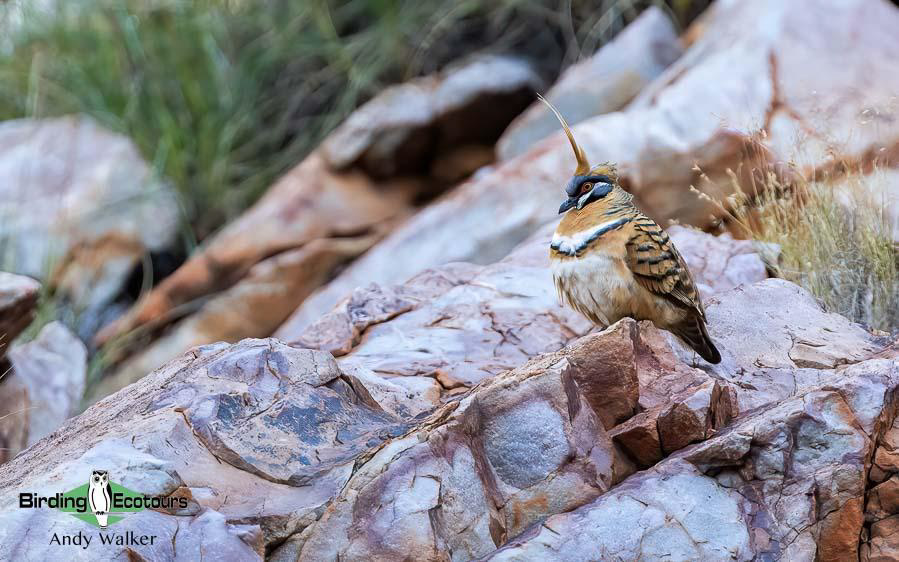
Spinifex Pigeon was a clear tour highlight, such a spectacular bird.
Detailed Report
Day 1, 20th September 2025. Arrival in Alice Springs
We met for a group welcome meal in the evening, discussing the plans for the coming week of birding in the arid Alice Springs and Uluru (Ayers Rock) areas. Several in the group had just completed our Northern Territory: Top End bird tour and were looking forward to expanding their Australian bird lists.
Day 2, 21st September 2025. Birding the Alice Springs area
We spent the morning driving into the arid bush to the southeast of Alice Springs. We noted a few birds along the way, such as Crested Pigeon, Black-shouldered Kite, Nankeen Kestrel, Pallid Cuckoo, Pied Butcherbird, Australian Magpie, several other common and widespread birds, and a mob of Black-footed Rock Wallabies.
Our first birding stop was at an area that looked pretty much like everywhere else we had driven through to that point, but we had a target to find and after walking around the bush for a while we got our main target, the tough Banded Whiteface. Two birds flew in to where we were birding and showed occasionally for a short while, before disappearing. Here we also saw Zebra Finch, Australian Pipit, Rufous Songlark, Grey-crowned Babbler, White-winged Fairywren, and our first Budgerigars of the trip, with several feeding on the ground at fairly close range – what a sight!
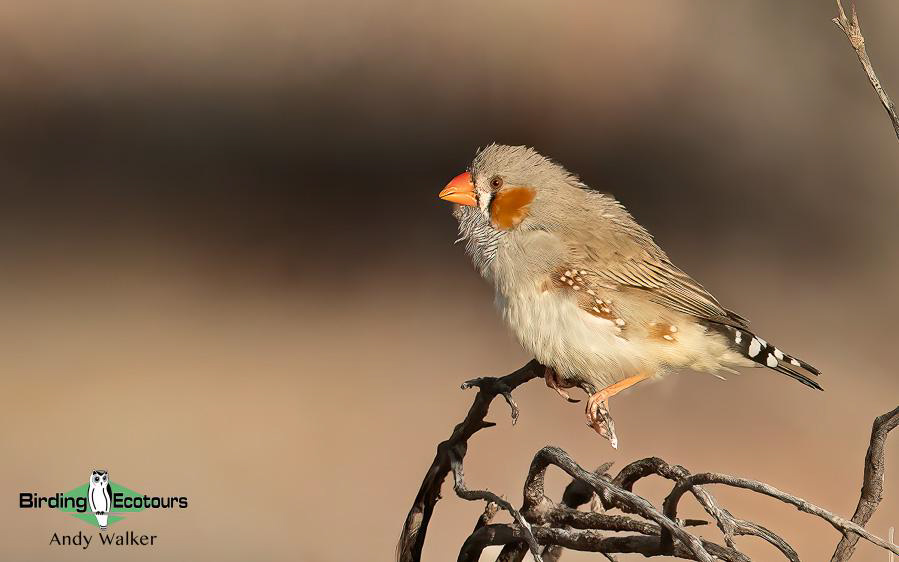
Known worldwide as a popular cage bird, it was exciting to see large numbers of wild Zebra Finches (and wild Budgerigars)around Alice Springs.
Continuing our drive, we had sightings of Red-backed Kingfisher, Black-faced Woodswallow, White-backed Swallow, and Central Bearded Dragon. We stopped at a rocky spinifex covered slope and commenced a slow walk. Not far after setting off a Spinifexbird was found, but it vanished as quickly as it appeared, unfortunately. After some considerable effort we were successful in obtaining views of another of our targets, when a pair of Dusky Grasswrens were seen, but alas, no emu-wrens, we would need to try again later in the tour. A Brown Falcon cruised overhead, giving good flight views of the characteristic features.
As we continued our drive we noticed a lot of activity so pulled over and found a larger flock of feeding Budgerigars with a flock of Masked Woodswallows also flying around and showing nicely. Further exploration of this area gave us close sightings of Horsfield’s Bronze Cuckoo, Rainbow Bee-eater, Crimson Chat, Southern Whiteface, White-winged Triller, Chiming Wedgebill, Red-capped Robin, Hooded Robin, Rufous Songlark, and Zebra Finch.
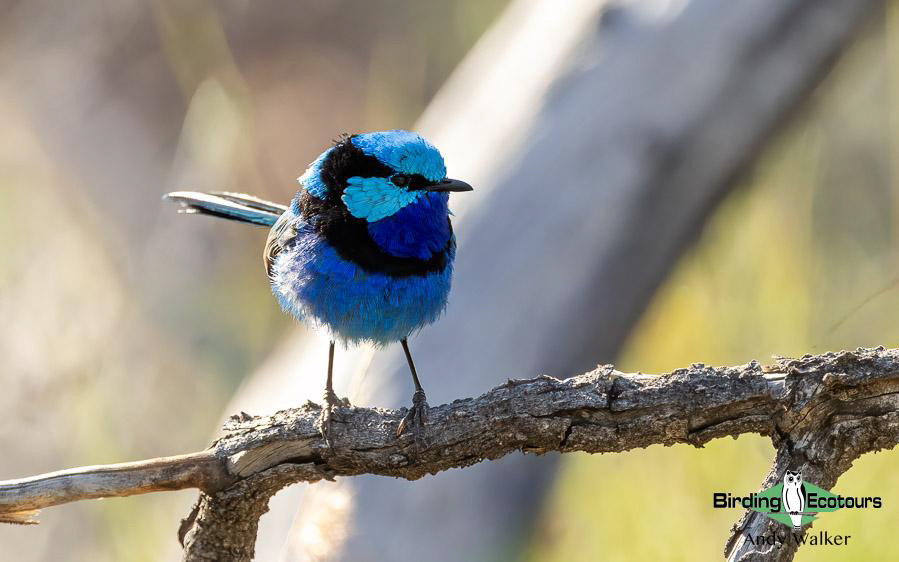
Splendid Fairywren was a popular and stunning sight.
We enjoyed lunch back in Alice Springs, and afterwards spotted Australian Ringneck, Western Bowerbird (great looks at the male tending his bower, which was very interesting), White-plumed Honeyeater, Yellow-throated Miner, nesting Willie Wagtails and Magpie-larks, and Little Crow.
After a short break in the middle of the day we headed out to the Alice Springs Desert Park entrance area, which turned out to be really exciting. The highlight here was an amazing display by Splendid Fairywrens with at least five males showing at once! As we walked around the bush, which was thriving after recent rain, we spied several raptors looking for a late afternoon snack, and included Black-shouldered Kite, Wedge-tailed Eagle, Collared Sparrowhawk, Brown Goshawk, Nankeen Kestrel, and Brown Falcon. Other smaller birds present (and constantly on the lookout for the above raptors), included White-fronted Honeyeater, Spiny-cheeked Honeyeater, White-plumed Honeyeater, Brown Honeyeater, Grey-crowned Babbler, White-browed Babbler, Black-faced Cuckooshrike, Rufous Whistler, Mistletoebird, and Zebra Finch.
Our final stop of the day was not far out of town along the escarpment where (after all the effort earlier in the day), we easily found a pair of Dusky Grasswrens! Here too we had sightings of Peregrine Falcon and Black Falcon, along with Grey-headed Honeyeater, Grey Shrikethrush, and Little Woodswallow.
It had been a wonderful introduction into birding in the “Red Center” of Australia, and we ended the day with a great meal at our hotel.
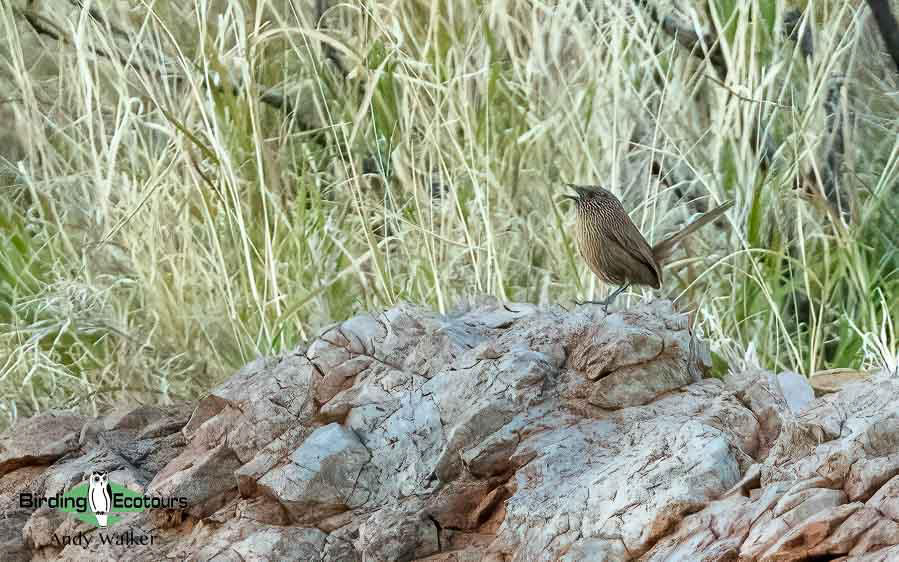
Dusky Grasswren hopped out onto a rock and out in the open just as the sun was setting.
Day 3, 22nd September 2025. Birding the Alice Springs area
We spent the morning birding in the West MacDonnell National Park. As we drove out of town some folks on one side of the vehicle got lucky with a brief flyover of a pair of Ground Cuckooshrikes, along with the more common roadside birds such as Little Corella, Galah, Spotted Dove, Nankeen Kestrel, and Black-shouldered Kite. Several Black-footed Rock Wallabies and a couple of Common Wallaroos were noted too.
At our first stop, a nice walk along a seasonally flooded river valley, we saw some more Budgerigars (nice and close perched views) and plenty of honeyeaters, including Black-chinned (Golden-backed) Honeyeater, Spiny-cheeked Honeyeater, and Grey-headed Honeyeater. Zebra Finches were moving through the area, occasionally perching nice and close allowing for good looks, and Australian Ringnecks were present but often slightly hidden from view. After a while we found our main target, when a Spinifex Pigeon jumped onto a rock in full view for us all to see. The bird sat still long enough for us to all get some really nice views of this most wanted and spectacular species. Shortly afterwards a Diamond Dove flew in and landed right above us and, just as we were about to leave the site, we spotted a Red-browed Pardalote which eventually showed nicely for us all.
After the success of the first birding stop we made one other stop in the national park, not too far away, and found even more new trip birds. The standout highlight here (in addition to the beautiful landscape) was undoubtedly Pink Cockatoo. We got some really nice views of a feeding bird and then another individual flew over calling and displaying its pretty underwing colors. A small lake held Australasian Grebe, Little Pied Cormorant, Eurasian Coot, Grey Teal, and Black-fronted Dotterel, while overhead we noted an Australian Hobby rapidly shooting through.
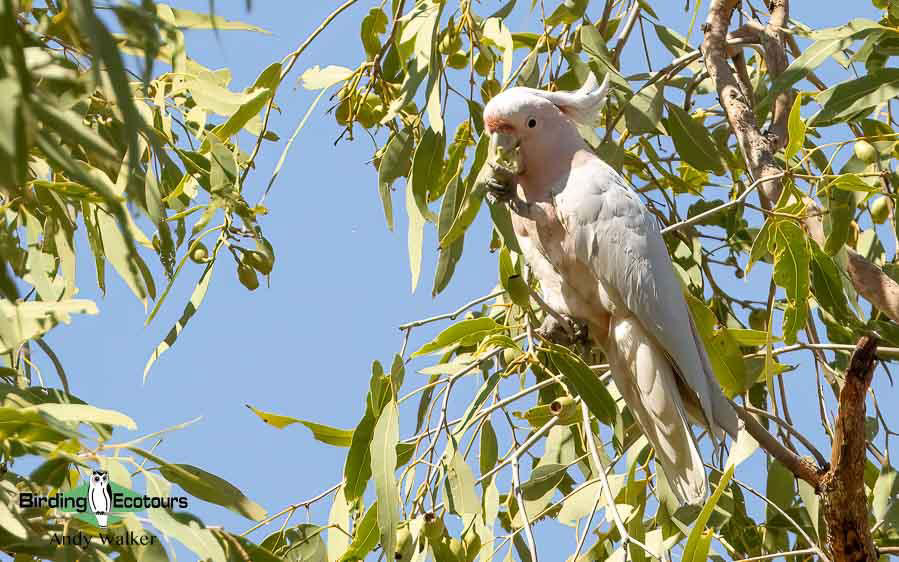
Pink Cockatoo was busily feeding and not bothered in the slightest by our presence!
In the afternoon we visited some Mulga woodland to the north of Alice Springs, where we found a couple of new birds, but the increased wind made conditions tough for birding. We made a short walk through the habitat and added a couple of new species for our trip, Western Gerygone and Chestnut-rumped Thornbill. Views of Red-capped Robin were improved for some, as were the views of Black-faced Cuckooshrike, Spiny-cheeked Honeyeater, and Singing Honeyeater. There were also further sightings of Splendid Fairywren, which is always a popular bird for some reason!
A short stop at a waterbody was quiet, but we had excellent views of both Pallid Cuckoo and Hooded Robin nearby. Some of the group had a brief sighting of a pair of huge Red Kangaroos that bounded alongside the vehicle for a short while. Driving back into Alice Springs as the sun set, we noted several more Black-shouldered Kites hunting along the roadside.
Day 4, 23rd September 2025. Alice Springs to Erldunda
We had an early morning birding session in the arid areas to the southeast of Alice Springs where we surprisingly quickly managed to find a rather cute male Rufous-crowned Emu-wren. A tiny bird that was amazingly good at vanishing from right in front of us – aided by some thick and impenetrable spinifex grass. We heard Dusky Grasswren but, given our pursuit of the emu-wren, we didn’t focus on seeing the grasswren this time. Nearby another Spinifexbird was briefly seen, but again eluded most of us, and by now the wind had picked up considerably and it was unlikely they would come and sit out in the open to get blown around. A pair of Wedge-tailed Eagles and a pair of Nankeen Kestrels appeared to be enjoying the wind a little more than us, and showed nicely. More Budgerigars were also seen, their fast flight even quicker today!
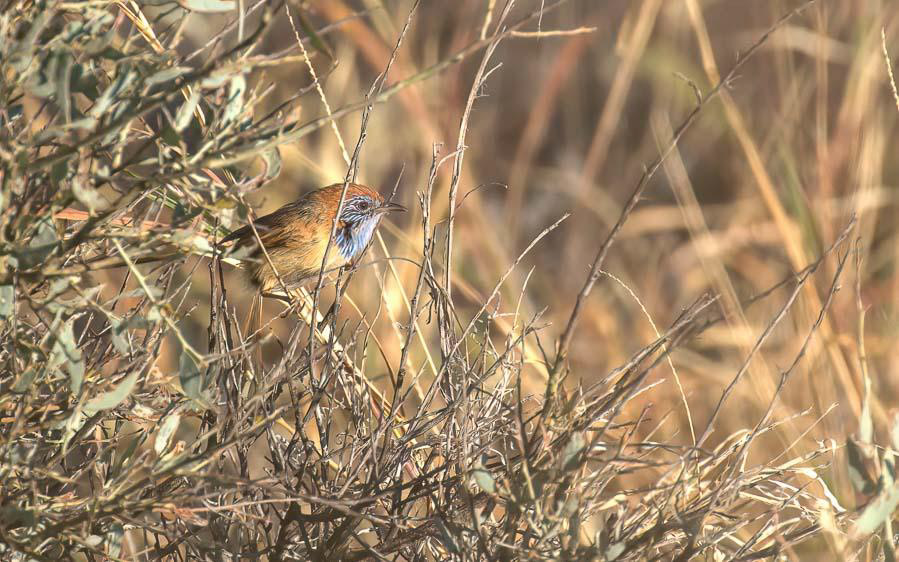
Rufous-crowned Emu-wren brieflyshowed closely (photo by tour participant Joi Inbody).
In the middle of the morning we departed Alice Springs to drive south to Erldunda. Along the way a brief roadside stop gave us our first Masked Lapwings of the tour and a better view of Australian Magpie. The usual roadside birds were noted, but unfortunately a nice Australian Raven coincided with a fast part of the road when most were sleeping. We made a couple of stops along the way, though these were not as productive as hoped, due to the increasing wind strength.
After lunch we stopped at a small dam and five minutes of bedlam ensued. Pulling up to the dam we saw an Australasian Darter, Hoary-headed Grebe, and a flock of Maned Ducks. A number of Zebra Finches and Budgerigars were coming in to drink, when suddenly a stooping Black Falcon came powering into the flock, trying to catch something. It missed but made two or three rapid dives and we watched on excitedly. A short while later, a Brown Goshawk came powering over and dived straight into the flock of Maned Ducks (which had by this point walked out of the water) and tried to catch one, getting within a matter of inches before the ducks got away. It was an exciting few minutes of avian chaos!
In the late afternoon we tried birding in an area of bush near to our accommodation that has given good results in previous years, however it was unfortunately largely quiet and still rather windy. We did have nice views of Mulga Parrot, White-backed Swallow, Crimson Chat, White-browed Babbler, and Southern Whiteface. A distant male Spotted Harrier flew through and Brown Falcons were quite showy, as were Masked Woodswallows. The major highlight here, however, was just as we were ending our birding session. A pair of very smart looking Australian Bustards were found walking very close to a road and allowed us lengthy close views.
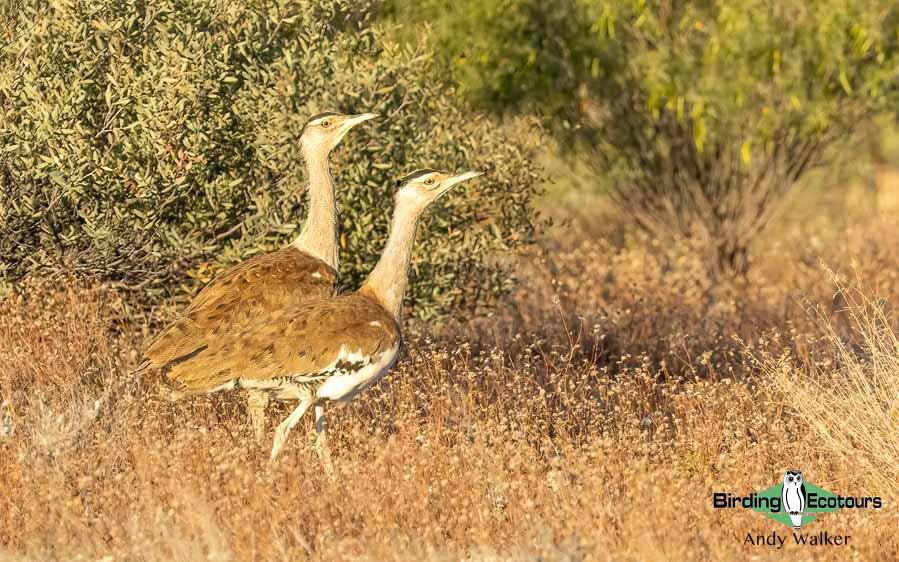
We enjoyed some close looks at a pair of Australian Bustards late in the afternoon.
Day 5, 24th September 2025. Erldunda to Uluru (Ayers Rock)
We had an early morning birding session near our accommodation but it was rather cold and activity was slow to get going. We did, however, see a gorgeous Mulga Parrot, Hooded Robin, Red-capped Robin, and a family of Purple-backed Fairywrens.
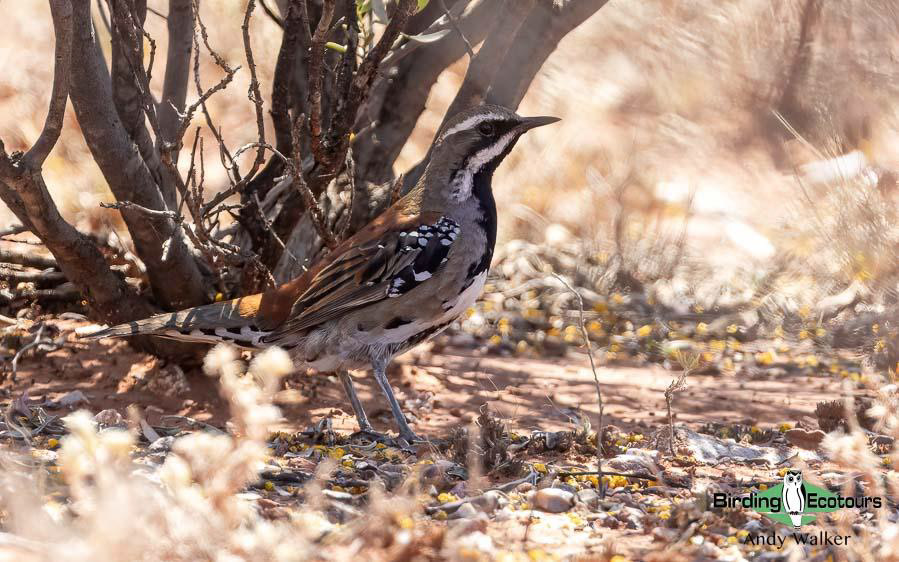
We enjoyed watching the very rare (in the Northern Territory) Copperback Quail-thrush on our way to Uluru.
After breakfast we commenced our drive towards Uluru. We made a couple of stops along the way, the first giving us some distant views of Chiming Wedgebill, Pied Honeyeater, and White-fronted Honeyeater (along with the usual roadside birds like Black-shouldered Kite, Nankeen Kestrel, and Brown Falcon). A second stop gave us our hoped-for Slaty-backed Thornbill and yet more Zebra Finches. A bit more time on the road gave brief sightings of Brown Songlark and Cockatiel for some. Our third stop provided quite a bit of excitement. We firstly accidentally flushed some unseen Australian Bustards, which then gave a nice fly over view before settling back into the bush nearby. Secondly, a Chiming Wedgebill eventually showed better than our previous views. Then finally, the highlight of the day, when we discovered a pair of Copperback Quail-thrushes. The male giving some nice views. This is a very rarely recorded species in the Northern Territory, so we were extremely lucky and very happy with our sighting.
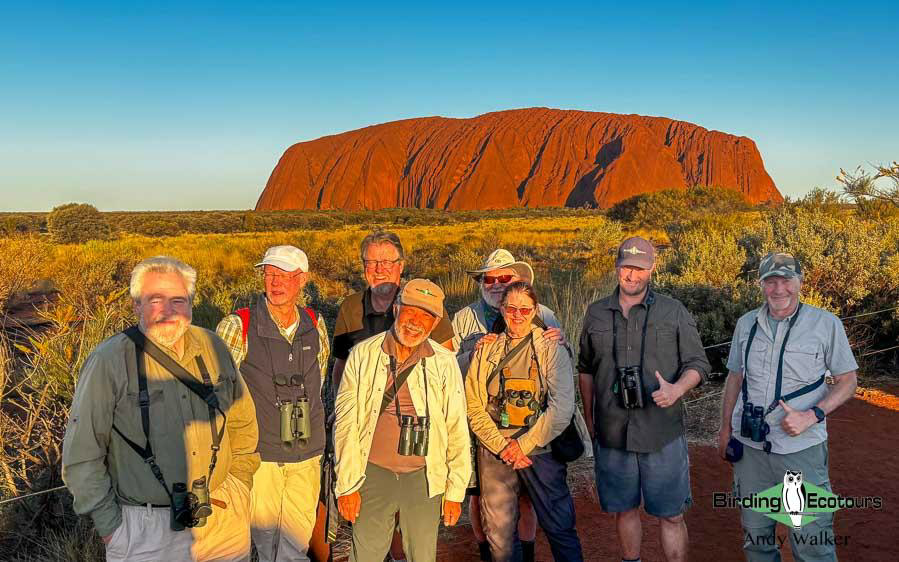
Our group watching the color of Uluru change through the afternoon.
In the late afternoon we visited Uluru to watch the changes in color that occurs as the sun sets here. An impressive sight indeed. Our focus was on Uluru, however we got some very close views of Singing Honeyeater, Spiny-cheeked Honeyeater, and Black-faced Woodswallows that were feeding near our viewpoint (as well as a gorgeous Leopard Ctenotus – a type of lizard). Afterwards we enjoyed a wonderful dinner in Yulara.
Day 6, 25th September 2025. Birding at Kata Tjuta (the Olgas) and travel to Alice Springs
After an early breakfast we set off for some birding at the base of the impressive Kata Tjuta rock formation (formerly known as the Olgas). After a drive through some beautiful landscapes (with another look at Uluru along the way), we quickly found our main target, the pretty Redthroat. Here too we also enjoyed further looks at Slaty-backed Thornbills, a vocal Inland Thornbill, and an attractive Monk (Inland Hooded) Snake.
After spending some time soaking up the views of Kata Tjuta, we commenced our journey back to Alice Springs. A brief stop along the way provided further views of Pallid Cuckoo, Chiming Wedgebill, Purple-backed Fairywren, and White-backed Swallow. Our drive back was uneventful, but we did note a couple of huge Wedge-tailed Eagles feeding on roadkill kangaroos. We arrived back in Alice Springs in the late afternoon where the tour concluded (or continued on to our Western Australia birding tour for some folk in the group).
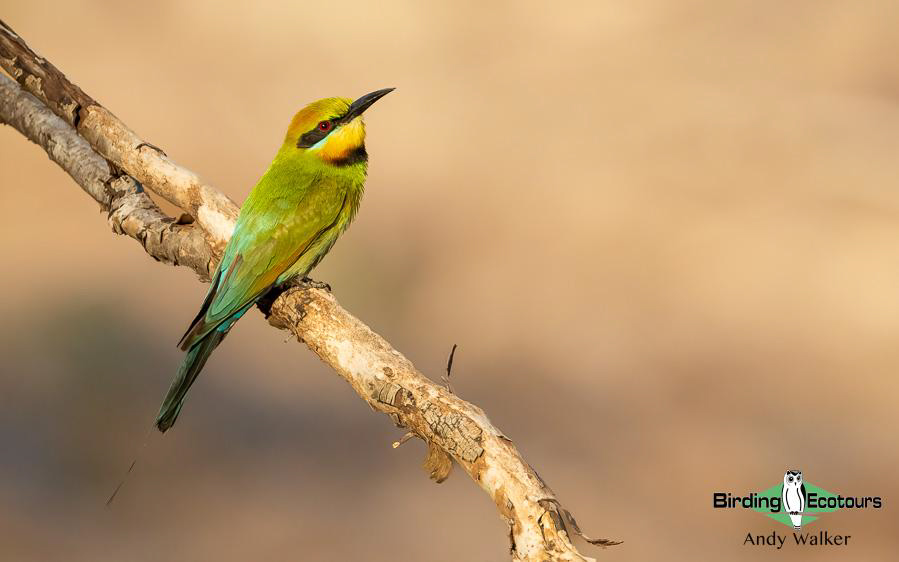
Rainbow Bee-eaters were seen on the tour and provided a stunning flash of color.
Bird List – Following IOC (15.1)
All species were seen. The following notation after species names is used to show conservation status following BirdLife International: VU = Vulnerable.
| Common Name | Scientific Name |
| Ducks, Geese, Swans (Anatidae) | |
| Maned Duck | Chenonetta jubata |
| Grey Teal | Anas gracilis |
| Bustards (Otididae) | |
| Australian Bustard | Ardeotis australis |
| Cuckoos (Cuculidae) | |
| Horsfield’s Bronze Cuckoo | Chalcites basalis |
| Pallid Cuckoo | Heteroscenes pallidus |
| Pigeons, Doves (Columbidae) | |
| Spotted Dove | Spilopelia chinensis |
| Common Bronzewing | Phaps chalcoptera |
| Crested Pigeon | Ocyphaps lophotes |
| Spinifex Pigeon | Geophaps plumifera |
| Diamond Dove | Geopelia cuneata |
| Rails, Crakes & Coots (Rallidae) | |
| Eurasian Coot | Fulica atra |
| Grebes (Podicipedidae) | |
| Australasian Grebe | Tachybaptus novaehollandiae |
| Hoary-headed Grebe | Poliocephalus poliocephalus |
| Buttonquail (Turnicidae) | |
| Little Buttonquail | Turnix velox |
| Plovers (Charadriidae) | |
| Black-fronted Dotterel | Charadrius melanops |
| Masked Lapwing | Vanellus miles |
| Anhingas, Darters (Anhingidae) | |
| Australasian Darter | Anhinga novaehollandiae |
| Cormorants, Shags (Phalacrocoracidae) | |
| Little Pied Cormorant | Microcarbo melanoleucos |
| Kites, Hawks, Eagles (Accipitridae) | |
| Black-shouldered Kite | Elanus axillaris |
| Wedge-tailed Eagle | Aquila audax |
| Collared Sparrowhawk | Tachyspiza cirrocephala |
| Brown Goshawk | Tachyspiza fasciata |
| Spotted Harrier | Circus assimilis |
| Black Kite | Milvus migrans |
| Whistling Kite | Haliastur sphenurus |
| Kingfishers (Alcedinidae) | |
| Sacred Kingfisher | Todiramphus sanctus |
| Red-backed Kingfisher | Todiramphus pyrrhopygius |
| Bee-eaters (Meropidae) | |
| Rainbow Bee-eater | Merops ornatus |
| Caracaras, Falcons (Falconidae) | |
| Nankeen Kestrel | Falco cenchroides |
| Australian Hobby | Falco longipennis |
| Brown Falcon | Falco berigora |
| Black Falcon | Falco subniger |
| Peregrine Falcon | Falco peregrinus |
| Cockatoos (Cacatuidae) | |
| Cockatiel | Nymphicus hollandicus |
| Galah | Eolophus roseicapilla |
| Pink Cockatoo | Cacatua leadbeateri |
| Little Corella | Cacatua sanguinea |
| Old World Parrots (Psittaculidae) | |
| Mulga Parrot | Psephotellus varius |
| Australian Ringneck | Barnardius zonarius |
| Budgerigar | Melopsittacus undulatus |
| Bowerbirds (Ptilonorhynchidae) | |
| Western Bowerbird | Chlamydera guttata |
| Australasian Wrens (Maluridae) | |
| Purple-backed Fairywren | Malurus assimilis |
| Splendid Fairywren | Malurus splendens |
| White-winged Fairywren | Malurus leucopterus |
| Rufous-crowned Emu-wren | Stipiturus ruficeps |
| Dusky Grasswren | Amytornis purnelli |
| Honeyeaters (Meliphagidae) | |
| Crimson Chat | Epthianura tricolor |
| Pied Honeyeater | Certhionyx variegatus |
| Brown Honeyeater | Lichmera indistincta |
| Black-chinned Honeyeater | Melithreptus gularis |
| White-fronted Honeyeater | Purnella albifrons |
| Singing Honeyeater | Gavicalis virescens |
| Grey-headed Honeyeater | Ptilotula keartlandi |
| White-plumed Honeyeater | Ptilotula penicillata |
| Spiny-cheeked Honeyeater | Acanthagenys rufogularis |
| Yellow-throated Miner | Manorina flavigula |
| Pardalotes (Pardalotidae) | |
| Red-browed Pardalote | Pardalotus rubricatus |
| Australasian Warblers (Acanthizidae) | |
| Redthroat | Pyrrholaemus brunneus |
| Southern Whiteface – VU | Aphelocephala leucopsis |
| Banded Whiteface | Aphelocephala nigricincta |
| Inland Thornbill | Acanthiza apicalis |
| Slaty-backed Thornbill | Acanthiza robustirostris |
| Chestnut-rumped Thornbill | Acanthiza uropygialis |
| Western Gerygone | Gerygone fusca |
| Australasian Babblers (Pomatostomidae) | |
| Grey-crowned Babbler | Pomatostomus temporalis |
| White-browed Babbler | Pomatostomus superciliosus |
| Whipbirds (Psophodidae) | |
| Chiming Wedgebill | Psophodes occidentalis |
| Jewel-babblers, Quail-thrushes (Cinclosomatidae) | |
| Copperback Quail-thrush | Cinclosoma clarum |
| Woodswallows, Butcherbirds & Allies (Artamidae) | |
| Masked Woodswallow | Artamus personatus |
| Black-faced Woodswallow | Artamus cinereus |
| Little Woodswallow | Artamus minor |
| Australian Magpie | Gymnorhina tibicen |
| Pied Butcherbird | Cracticus nigrogularis |
| Cuckooshrikes (Campephagidae) | |
| Ground Cuckooshrike | Coracina maxima |
| Black-faced Cuckooshrike | Coracina novaehollandiae |
| White-winged Triller | Lalage tricolor |
| Australo-Papuan Bellbirds (Oreoicidae) | |
| Crested Bellbird | Oreoica gutturalis |
| Whistlers & Allies (Pachycephalidae) | |
| Rufous Whistler | Pachycephala rufiventris |
| Grey Shrikethrush | Colluricincla harmonica |
| Fantails (Rhipiduridae) | |
| Willie Wagtail | Rhipidura leucophrys |
| Monarchs (Monarchidae) | |
| Magpie-lark | Grallina cyanoleuca |
| Crows, Jays (Corvidae) | |
| Torresian Crow | Corvus orru |
| Little Crow | Corvus bennetti |
| Australian Raven | Corvus coronoides |
| Australasian Robins (Petroicidae) | |
| Red-capped Robin | Petroica goodenovii |
| Hooded Robin | Melanodryas cucullata |
| Swallows, Martins (Hirundinidae) | |
| White-backed Swallow | Cheramoeca leucosterna |
| Fairy Martin | Petrochelidon ariel |
| Grassbirds & Allies (Locustellidae) | |
| Spinifexbird | Poodytes carteri |
| Brown Songlark | Cincloramphus cruralis |
| Rufous Songlark | Cincloramphus mathewsi |
| Flowerpeckers (Dicaeidae) | |
| Mistletoebird | Dicaeum hirundinaceum |
| Waxbills, Munias & Allies (Estrildidae) | |
| Australian Zebra Finch | Taeniopygia castanotis |
| Wagtails, Pipits (Motacillidae) | |
| Australian Pipit | Anthus australis |
| Total seen | 94 |
| Total heard only | 0 |
| Total recorded | 94 |
Reptile List
| Common Name | Scientific Name |
| Dragons (Agamidae) | |
| Central Bearded Dragon | Pogona vitticeps |
| Skinks (Scincidae) | |
| Leopard Ctenotus | Ctenotus pantharinus |
| Elapid Snakes (Elapidae) | |
| Monk (Inland Hooded) Snake | Parasuta monachus |
| Total | 3 |
Mammal List
| Common Name | Scientific Name |
| Kangaroos, Wallabies, and Allies (Macropodidae) | |
| Common Wallaroo | Osphranter robustus |
| Red Kangaroo | Osphranter rufus |
| Black-footed Rock Wallaby | Petrogale lateralis |
| Camelids (Camelidae) | |
| Dromedary Camel | Camelus dromedarius |
| Canids (Canidae) | |
| Feral Dog (Dingo) (H) | Canis familiaris dingo |
| Hares and Rabbits (Leporidae) | |
| European Rabbit | Oryctolagus cuniculus |
| Total | 6 |
This is a sample trip report. Please email us ([email protected]) for more trip reports from this destination.
